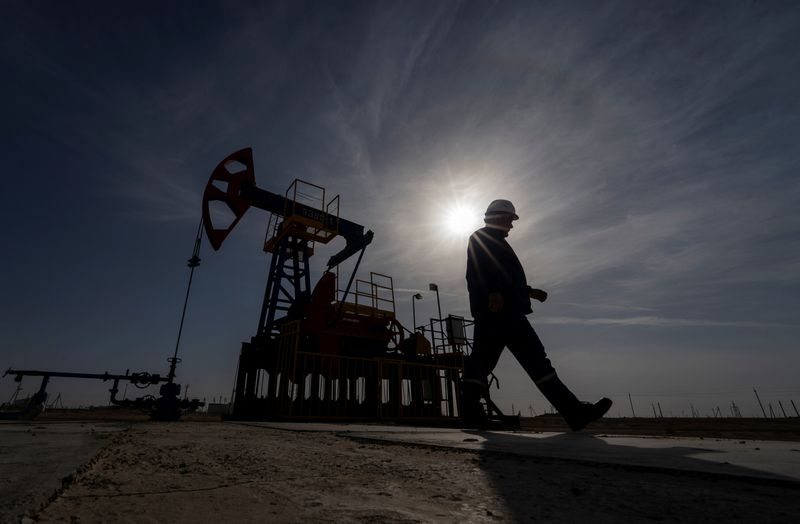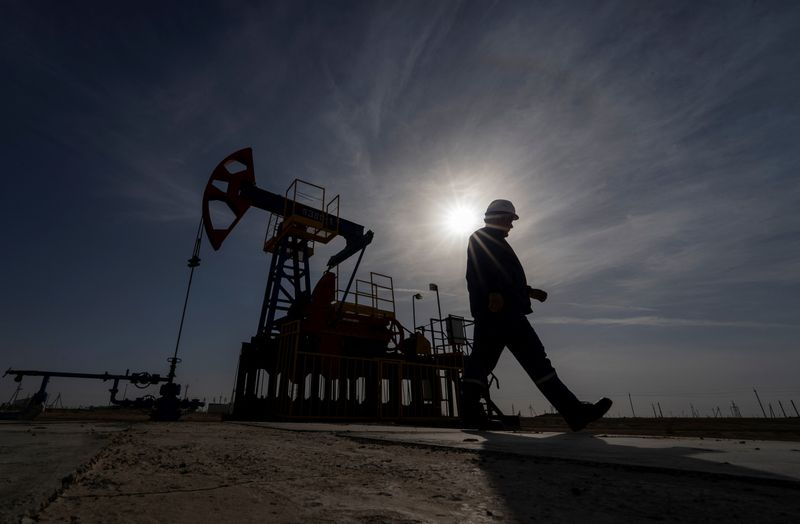Commodities
Oil prices drift up with focus on Middle East


© Reuters. FILE PHOTO: An oil and gas industry worker walks during operations of a drilling rig at Zhetybay field in the Mangystau region, Kazakhstan, November 13, 2023. REUTERS/Turar Kazangapov/File Photo
By Paul Carsten
LONDON (Reuters) -Oil prices edged up on Tuesday as uncertainty over fighting in the Middle East kept markets on edge, but gains were capped by concerns that continued high interest rates may weigh on energy demand.
futures were up 54 cents to $82.54 a barrel at 1224 GMT. U.S. West Texas Intermediate (WTI) crude was up 50 cents at $77.42 a barrel. Saudi state oil company Aramco (TADAWUL:) has started trading WTI, which underpins the global Brent benchmark.
Oil prices were near flat in Monday’s trade, after gaining 6% last week.
The conflict in the Middle East has kept prices elevated. U.S., Egyptian, Israeli and Qatari officials were expected to meet in Cairo on Tuesday to seek a truce in Gaza as more than a million civilians crammed into a southern corner of the Palestinian enclave, waiting in fear for an Israeli assault.
“Oil prices have been numbed into submission by what has transpired, or not, in the Middle East,” said John Evans of oil broker PVM in a note on Tuesday.
One “untoward act, missile or sudden peace agreement and crude prices will move $10/barrel”.
Yemen’s Iran-aligned Houthis have kept up their attacks in the Red Sea, claiming solidarity with Palestinians and striking vessels with commercial ties to the U.S., Britain and Israel since mid-November.
But changing expectations over the path of U.S. interest rates have limited price gains, with recent central banker comments dashing market speculation of rate cuts early this year.
The New York Fed’s January Survey of Consumer Expectations showed the outlook for inflation a year and five years from now remained above the Fed’s 2% target rate.
If inflation worries delay Fed interest rate cuts, that could dampen economic growth and hit oil demand.
U.S. inflation data is expected on Tuesday, while British inflation and euro zone gross domestic product data should land on Wednesday. Germany, the powerhouse of Europe’s economy, is not in recession and is expected to grow in 2024, Chancellor Olaf Scholz’s chief of staff, Wolfgang Schmidt, said on Tuesday.
inventories figures are also due later on Tuesday, with analysts estimating they rose an average of about 2.6 million barrels in the week to Feb. 9.
The Organization of the Petroleum Exporting Countries is scheduled to release its monthly oil market report on Tuesday. Its secretary general said on Tuesday he believes the long-term oil demand outlook is robust.
The group’s next major decision will come in March, when it and allies including Russia, known as OPEC+, will decide whether to extend voluntary oil production cuts.
“Our balance sheet suggests that the market will be in surplus in the second quarter of 2024 if the group fails to roll over part of these cuts,” ING analysts said in a Tuesday note.
Commodities
Oil prices rise; U.S. crude inventories plunge, Russia-Ukraine truce eyed
Commodities
India’s Reliance to stop buying Venezuelan oil over US tariffs, sources say
Commodities
Oil prices climb on Venezuela supply worries

 Forex3 years ago
Forex3 years agoForex Today: the dollar is gaining strength amid gloomy sentiment at the start of the Fed’s week

 Forex3 years ago
Forex3 years agoUnbiased review of Pocket Option broker

 Forex3 years ago
Forex3 years agoDollar to pound sterling exchange rate today: Pound plummeted to its lowest since 1985

 Forex3 years ago
Forex3 years agoHow is the Australian dollar doing today?

 Cryptocurrency3 years ago
Cryptocurrency3 years agoWhat happened in the crypto market – current events today

 World3 years ago
World3 years agoWhy are modern video games an art form?

 Commodities3 years ago
Commodities3 years agoCopper continues to fall in price on expectations of lower demand in China

 Economy3 years ago
Economy3 years agoCrude oil tankers double in price due to EU anti-Russian sanctions























